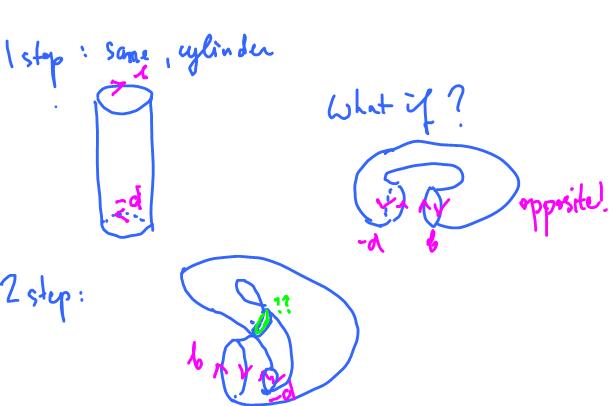This site is being phased out.
Klein bottle
Just like the torus, it a tire - with a twist.
This is how the torus is constructed from the cylinder via gluing:
The Klein bottle is obtained by attaching one edge of the cylinder to the other - but only only in the opposite direction.
If we try to follow the gluing procedure we used for the cylinder, we get stuck because $b$ and $-d$ aren't aligned and can't be glued together. We have to flip $d$ for alignment but then to get the ends of the cylinder together we have to go through its side!
The Klein bottle is a surface, i.e., it's locally homeomorphic to the plane. It is a non-orientable surface as it contains the Mobius band.
The Euler characteristic is $$\chi({\bf K}^2) = 1 - 2 + 1 = 0.$$
Let's compute its homology:
- cycle group $Z_1(K)= \ker \partial = {\rm \hspace{3pt} span \hspace{3pt}} \{a, b \},$
- boundary group $B_1(K) = {\rm \hspace{3pt} span \hspace{3pt}} \{ \partial \tau \} = {\rm \hspace{3pt} span \hspace{3pt}} \{a + b - a - b \} = {\rm \hspace{3pt} span \hspace{3pt}} \{0 \} = 0$, so
- homology group, $H_1(K) = {\rm \hspace{3pt} span \hspace{3pt}} \{a, b \} / 0 = {\rm \hspace{3pt} span \hspace{3pt}} \{a, b \}$.
In particular, the the first Betti number is $2$.
So, the homology over ${\bf R}$ $${\bf R}, {\bf R}^2, {\bf R}, 0, ...$$ does not distinguish the Klein bottle from the torus, but the homology over ${\bf Z}$ does (see Homology as a group).



